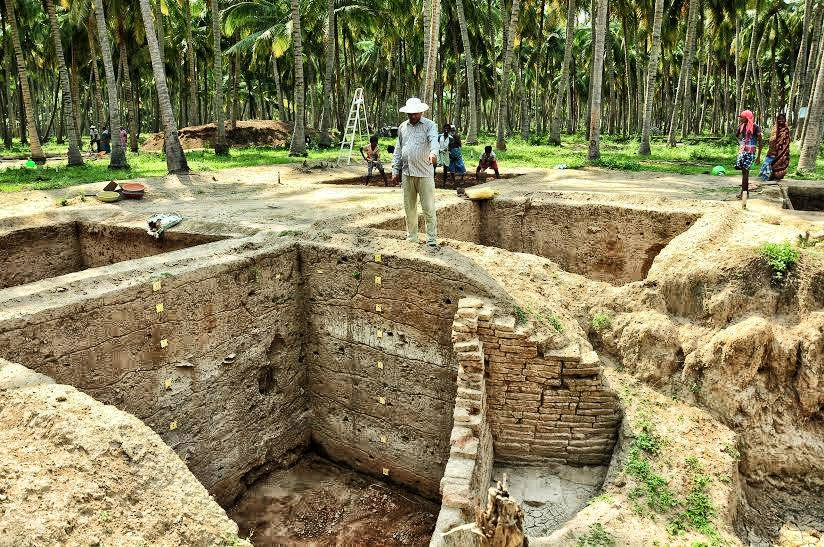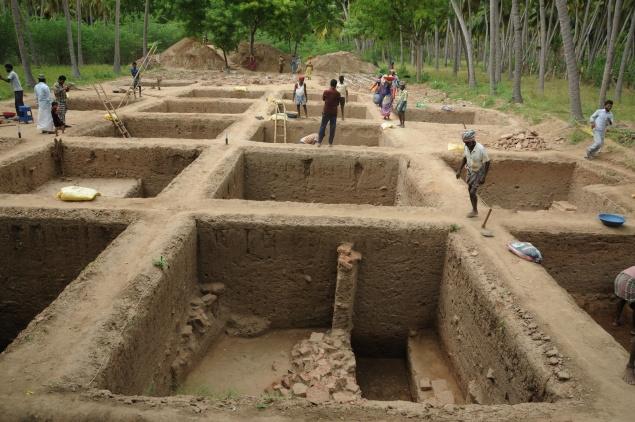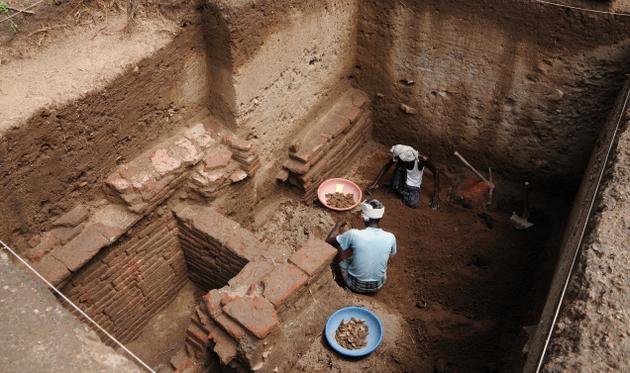Many may not know South Indian ancient cities flourished more than Mohenjodaro and Harappa. Couple of excavations reveals three advanced civilizations including Keeladi existed about 2,000 years ago during the era of Pandya and Chola dynasties. Here we will mostly discuss about the recent finding, though incomplete due to slowed down excavation works, Keeladi/Keezhadi civilization that is also called Harappa of South India or Tamil Nadu.
Keeladi Civilization Location
Keeladi is the 2nd century BCE settlement near Silaiman in the Indian state of Tamil Nadu. The small village is also spelled as Keezhadi and located on the border between Sivagangai and Madurai districts. It is 12 km southeast of Madurai city and found on the shores of Vaigai river.
From excavation it is learned Keeladi existed in the Sangam period, the period in which the ancient Tamil Nadu and Kerala spanned between 5th century BCE and 3rd century CE. It is believed to be as big as Mohenjodaro and Harappa. It was an advanced civilization having international trade links like with Rome, Egypt and China.
Keeladi excavation
The excavation started in Pallisanthai Thidal, which lies about a kilometer east of Keeladi town in Sivagangai district. Initially some archaeological residues were discovered and so a study survey was selected. The current excavation of the site spreads about 80 acres and 4 meters below thick cover of coconut estate. It is believed ancient towns of Manalur and Kondagai are associated with the region.
Keeladi age

As per carbon dating from the excavation the Keeladi site is estimated to be from 3rd century BC to 10th century AD. This means it is about 2,200 years old and flourished during the Pandya dynasty that spanned between 300 BCE and 1650 CE in southern India.
Keeladi civilization
The Keeladi civilization was rich and flourished on the banks of Vaigai. It was beyond caste and creed and people spent their time on games. Several gaming equipments have been found from the excavation. It was an advanced civilization equipped with closed drainage system, small storage rooms, ring wells of terracotta, organic processing units and many more.
Keeladi artifacts
The artifacts discovered from Keeladi excavation includes stone celts which were used to sharpen tools, terracotta structures depicting earlobes, decorated pots, terracotta furnaces, coins from the Pandaya and Chola period in circular and square shapes, arrowheads made of bones and iron, chess games made of ivory, iron implements such as knives and daggers, and gold beads.
Articles from foreign origin such as Far East and Rome were found too. Hence it is believed the civilization had trade connections with West and East. It is believed the Keeladi habitat had industrial town from the 3rd century BC.
All these makes the claim wrong that Sangham era was just imaginations. With the Keeladi excavation it is believed the era did exist.
The developed farming, trade links with developed civilizations and planned urban settlements prove the era was more advanced in time than the Aryan civilization, which was based on grazing cattle, temporary civilization and nomadic life.
What more to learn from Keeladi

It is yet to learn whether Keeladi had links with Sindh and to learn difference between Vedic civilization and Sindh and Dravidic civilization.
The Vedic civilization was based on cattle rearing while Dravidic civilization on farming.
Why Keeladi failed to reach main stream media?
The Keeladi excavation was abruptly stopped believing the habitat could be from the non-vedic and non-Aryan indigenous settlement. Initially, when the digging started couple of years ago, it was not thought the excavation could be of such an importance and would force historians to rewrite ancient India history. It was not thought such a complex ancient civilization could ever be excavated in Southern India or in Tamil Nadu before. These were the cumulative reasons the Keeladi excavation couldn’t reach main stream media as it should be.
Archaeologists believe the digs made until now is even more important than what has been seen at the Adhichanallur. Researchers found ten buildings, more than 100 trenches, decorated pots, terracotta drainage system, wells protected with terracotta rings, coins from the eras of Pandiya and Chola, and many more. All the artifacts are dated about 2300 years old, revealing those belonged to the population of about 2,000 years ago.
Keeladi excavation significance
It is significant that the Keeladi era was a secular civilization and it belonged to the Sangam era. More excavation work is awaited to reveal traces of a more secular culture that existed in Tamil Nadu thousands of years ago when the region was named as Thanizhagam.
Keeladi, Mohenjodaro, Harappa
About 13,638 artifacts have been discovered from the Keeladi archaeological sites and it is said the number is more than those found from Mohenjodaro and Harappa excavation.
According to Central Advisory Board for Archaeology (ASI) six tiny gold ornaments have been unearthed from the excavation site. The biggest ornament weighs 0.9 gram. It is yet to study to know significance of ornaments in the civilization. The ornaments included a button, a needle and a tiny star-shaped pendant.
Sangam literature mentions Keeladi?

Sangam literature is ancient Tamil literature and it speaks about the history of south India that spanned from 300 BCE to 300 CE. Tamil Nadu was then called as Thamizhagam or Tamilagam. It contains 2381 poems composed by 473 poets. However, more than 100 poets are anonymous. It is learned the Pandya dynasty patronized the three Sangams.
Sangam literature is categorized in inner field and outer field. The first talks about human aspects like relationships, emotion and love while the second reveals human experience aspects like ethics, courage, customs, social life and heroism.
Pandya dynasty
The Pandya dynasty spanned between 300 BCE and 1650 CE. It was an ancient Tamil dynasty. It initially ruled the country called Pandya Nadu from a seaport on the southernmost tip of Indian Peninsula named Korkai. Later it moved to Madurai. It had diplomatic relations with Rome as mentioned in Greek Megasthenes. In 3rd century text by Chinese historian Yu Huan the dynasty has been mentioned. It is learned the Pandya dynasty also had trade contacts with Ptolemaic Egypt.
Other civilizations excavated in Tamil Nadu
A total of three civilizations including keeladi civilization have been excavated in Tamil Nadu and the other two are Arikamedu and Kaveripoompattinam.
The Arikamedu site is in Kakkayanthope, Ariyankuppam Commune, Puducherry. Finding from excavation reveals the civilization was part of 1st century BCE to 1st and 2nd centuries CE. Two walled enclosures equipped with drainage systems and ponds have been found indicating it was a dyeing operations infrastructure used to dye export quality muslin. Arrentine ware, amphorae and various more potteries have been unearthed belonging to the Terra Sigillata (stamped pottery) of the era. More to all these, gold, terracotta, gems, shell beads, iron nails, Roman lamp shade and copper percussion beater were found from the site.
During the reign of Cholas Kaveripoompattinam was a major port. The original city has been submerged by the sea and only a small village has been unearthed in excavation. It is an ancient and planned city that was built about 2000 years ago. It is located in the Sirkazhi taluk of Nagappatinam district. Several ring wells, a feet of Buddha, coins used in Chola Karikalan period, Roman copper coin, copper statue of Buddha and more artifacts have been unearthed from the excavation site.
Latest update on Keeladi excavation
The Madras High Court directed earlier this year (March 2019) the transfer of ASI officer Amarnath Ramakrishna back to Tamil Nadu from Assam. He had earlier led the Keeladi excavation works.
The court said after the completion of Keeladi excavations the pride of Tamil Nadu will be recognized across the world.
The Keeladi excavation works met with controversies earlier when the central government delayed allocating funds in 2016 and later with the transfer of Amarnath to Assam in 2017. In 2018 the officer was not allowed to file his final report on the findings. Until now four phases of the project have been completed and about 15,000 artifacts have been found.




